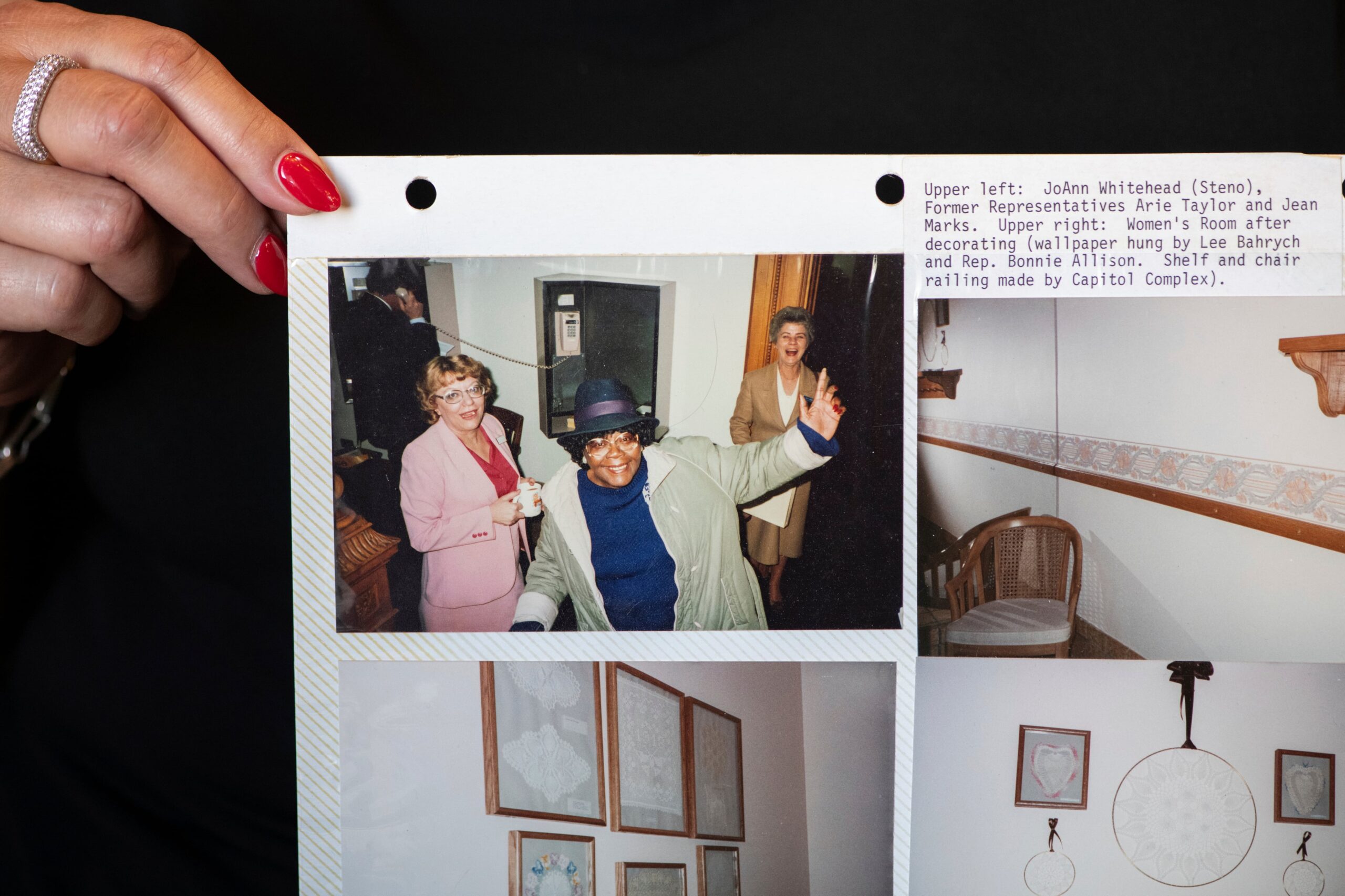By Claire Rush and Kimberlee Kruesi, Associated Press
In Kentucky, female state legislators have long had to carefully choose when to use the restroom.
The House and Senate chambers are on the third floor of the Kentucky Statehouse, which has only two women’s restrooms. When 41 of the 138 members of the Legislature require a break during a long floor session, they must consider the possibility of missing a crucial vote or debate.
Naturally, there are several men’s restrooms available, so none of their male coworkers have the same problem. To ensure they don’t miss anything crucial, the Legislature even placed speakers in the men’s restrooms to broadcast chamber activities.
House Speaker David Osborne permits women to use his chamber’s single-stall restroom in an emergency, but even that draws huge waits.
Rep. Lisa Willner, a Democrat from Louisville, said of the pictures of former politicians, mostly men, that adorn her office, “You get the message very quickly: This place was not really built for us.”
Kathryn Anthony, a professor emerita at the University of Illinois at Urbana-Champaign’s School of Architecture, stated that although the problem of toilet parity may appear humorous, its effects extend beyond uncomfortable full bladders.
Anthony, who has testified before Congress on the matter, stated that it is really important since the built environment is a reflection of our culture and population. A group of disadvantaged and disenfranchised people results when an environment is created for half of the population while neglecting the other half.
For Kentucky’s female lawmakers hoping for more chamber seats, there is hope.
More women’s facilities and an end to Kentucky’s bathroom imbalance are the goals of a $300 million makeover of the 155-year-old Capitol, which is expected to be finished by 2028 at the latest.
Built before female lawmakers were taken into account, the Bluegrass State is one of the last states to upgrade its historic statehouses with restrooms.
According to Gerald Pilgrim, chief of staff with the state’s Building Authority, increasing restroom access is a top objective in the $392 million reconstruction of the Georgia Capitol. In order to comply with the Americans with Disabilities Act, it will expand extra restrooms throughout the building and provide female facilities on the fourth floor, which houses the public galleries.
“We are aware that there aren’t enough restrooms,” he stated.
Evolving equality in statehouses
No federal legislation mandates that people of all genders have access to restrooms in public facilities. There are laws in about 20 states that specify the number of restrooms that buildings must contain, but historic structures like statehouses are frequently exempt.
Women’s restrooms have been installed to statehouses as the composition of state governments has evolved throughout time.
The architects of Tennessee’s Capitol only included one male-only restroom on the ground floor when it debuted in 1859. Only after sufficient rainwater had been collected, according to legislative librarian Eddie Weeks, could the toilet be flushed.
Weeks wrote in an email that the chamber was infamously described as a “stench in the nostrils of decency.”
A women’s restroom is now situated between the Senate and House chambers in Tennessee’s Capitol. It has only two stalls and is located in a small hallway beneath a staircase, drawing similarities to Harry Potter’s cupboard bedroom. On the same floor, the males only have one bathroom, although it contains three urinals and three stalls.
Rep. Aftyn Behn, a Democrat elected in 2023, claimed she was unaware of the facility difference until The Associated Press contacted her.
According to her, I’ve come to terms with the fact that standing in line for a two-stall closet beneath the Senate balcony is a necessary part of the job.
I fought to be elected to a legislature that has the lowest percentage of female representation, and now I get to live in a room that seems to have been created by someone who didn’t believe that women existed, or at the very least, didn’t have bladders, Behn said.
Operating since the late 1700s, the Maryland State House is the oldest state capitol in continuous legislative use in the nation. Because desegregation rules were still in effect, archivists claim that the restrooms were originally designed exclusively for white men. After 1922, women’s lavatories were constructed, but there weren’t enough to accommodate the growing number of elected female officials.
In 1972, House Speaker Thomas Lowe gave delegate Pauline Menes a fur-covered toilet seat in front of her peers after she complained about the problem so much that he made her chair of the Ladies Rest Room Committee. The following year, she started the women’s caucus.
The first woman to hold the top job, House Speaker Adrienne A. Jones, didn’t order the construction of additional women’s restrooms, a gender-neutral lavatory, and a nursing space for mothers in the Lowe House Office Building until 2019.
No longer do we fret and squirm or cross our legs in panic
Some came up with inventive solutions as more women were elected across the country in the 20th century.
It wasn’t until 1988 that a facility was provided to the chamber’s cloakroom for female senators in Nebraska’s unicameral legislature. According to Brandon Metzler, the secretary for the Legislature, Sen. Shirley Marsh, who had been in office for about 16 years, would ask a State Patrol trooper to watch the door while she used the one restroom that was previously available in the senate lounge.
When Colorado’s first Black female lawmaker, then-Rep. Arie Taylor, advocated for the addition of a lavatory in the chamber’s hallway in 1987, female House legislators and staff were so thrilled that they placed a plaque in her honor.
If nature called, we would have to get up from our seats and run across the hall, according to the plaque, which is currently located in a women’s restroom in the Capitol. We no longer worry and writhe or cross our knees in fear as Arie took the microphone again to push an urge organic.
In remembrance of you, Arie (may you always be remembered), we will henceforth refer to that room as the Taylor Chamber Pot, the poem ends.
In 2013, Liz Thomson, a Democratic state representative from New Mexico, recounted that she missed votes in the House during her first year in office because the chamber’s lounge lacked a women’s restroom. She noted that the issue was made more widely known by the fact that New Mexico elected the greatest female majority Legislature in U.S. history in 2024.
“It may seem like fluff, but it’s not,” she remarked. It truly discusses inclusivity and respect, in my opinion.
Statehouses are not the only place where the problem exists. It wasn’t until 1962 that the first women’s restroom opened in the U.S. Capitol. Although a restroom for female U.S. senators was made available in 1992, the House chamber did not establish a restroom for female lawmakers until 2011.
The first elected female member of Congress was Jeannette Rankin of Montana. That was in 1916.
Willner maintains that she is more motivated to speak up and be heard since she is aware that the Kentucky Capitol was not built with women in mind.
She claimed that this building was not intended for me. Guess what, though? I’m present.
Brian Witte of Annapolis, Maryland, wrote for the Associated Press.
Pivotal Ventures provides funding to the Associated Press for coverage of women in the workforce and state government. All content is the exclusive responsibility of AP. Visit AP.org to find funded coverage areas, a list of supporters, and AP rules for dealing with philanthropies.
More in Nation-World News
-
Shooting with multiple injuries reported at Nevada casino with a suspect in custody
-
Trump calls for more Gaza food aid, talks up his golf course in meeting with UK s prime minister
-
Comet might in fact be an alien object, paper asserts






